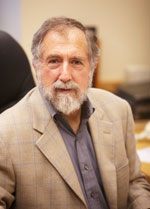August 8, 2012 — There is a growing shortage of health care workers worldwide — particularly in Sub-Saharan Africa — and the consequences can be seen daily in mothers dying from preventable childbirth complications, children suffering from severe diarrhea, and communities turning away from formal health care systems they don’t trust. Harvard School of Public Health Lecturer on Global Health Marc Mitchell witnessed this firsthand as a pediatrician at a hospital in rural Tanzania, and he has worked for decades to improve health infrastructures and increase access to care in developing countries around the world. Now, he’s getting the job done by leveraging the power of a device common in even the poorest countries — the mobile phone.
“The phone is my tool, like a stethoscope is for doctors,” Mitchell told an HSPH audience on July 24, 2012 as part of the summer Hot Topics lecture series. Advances in mobile technology have led to an explosion in the field of mHealth, which Mitchell explained is about more than empowering rural health workers to send a text message requesting supplies or to call a doctor with questions. Smart phones now have the capability to take a picture of a patient’s rash and diagnose it, for example. And with attachments, phones can even be used as microscopes and ultrasounds.
Mitchell’s work focuses on providing health care workers with the tools to more accurately diagnose and treat patients. He is the founder and president of D-tree International, a non-profit that develops “decision trees,” or medical protocols that guide health workers through a series of questions about the patient’s symptoms, leading ultimately to a recommended treatment. The company also develops software that allows workers to follow the externally validated protocols on their phone instead of a cumbersome manual, and to store patients’ medical records on a cloud-based server.
Mitchell studies the effectiveness of the work through his research at HSPH. A child health study he conducted in Tanzania found that health workers followed the protocols more closely on their phones than when using the manuals. The reason, the researchers found, was that workers felt embarrassed to thumb through manuals in front of their patients, whereas following the protocols on their phones allowed them to look more authoritative. Diagnoses also improved, particularly for kids with severe conditions such as pneumonia and diarrhea, Mitchell said. The workers were happy with the application’s ease of use, and the children’s mothers felt that they received higher quality care.
D-tree received funding from a Gates Foundation Challenge Grant to develop mobile software that uses clinical algorithms to help health workers quickly identify women at risk during labor and home delivery and helps them locate and pay for emergency transfer to a hospital.
Another of D-tree’s programs focuses on child malnutrition in Zanzibar. The protocol takes workers step-by-step through treatment of malnourished kids and allows them to track each child’s target weight.
“Our goal is that every patient who comes into a clinic will see a health worker with a mobile device like a phone or tablet that takes the worker through a protocol, links to a record, and enables us to track what’s going on,” Mitchell said. “This is the way health care is going in the United States and around the world. We are trying to accelerate the process so that the benefits go not just to people who can afford it but to everyone.”
–Amy Roeder
Mobilizing a Revolution: How Cellphones are Transforming Public Health (Harvard Public Health)
New Technology Not Enough: Dean Frenk Calls for Change in Global Health Systems at mHealth Summit (HSPH News)
